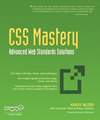There’s a plethora of books and Internet resources on the subject of designing websites with Cascading Style Sheets (CSS) but whether you are just starting out as a complete novice or have solid, intermediary experience this book offers a very useful grounding in theory and application.
 The foundation chapter provides a clear and easy to understand introduction to meaningful markup techniques for CSS “hooks” — divs, spans, ids and classes as well as discussion on DOCTYPEs, browser modes and validation before diving in to CSS selector types, the cascade and specificity. The chapter finishes with discussion on how best to organise your stylesheets — no, don’t just lump it all together in a single file
The foundation chapter provides a clear and easy to understand introduction to meaningful markup techniques for CSS “hooks” — divs, spans, ids and classes as well as discussion on DOCTYPEs, browser modes and validation before diving in to CSS selector types, the cascade and specificity. The chapter finishes with discussion on how best to organise your stylesheets — no, don’t just lump it all together in a single file ![]()
The second chapter is a very useful recap of the visual formatting model (i.e. the box model and absolute / relative / float positioning) and will serve as a great reminder for when your complex layouts start to misbehave — something that all CSS practitioners will experience at some point.
The bulk of the book covers styling specific elements of your design and includes layout, image replacement, styling links, lists, forms and tables. People tend not to get too adventurous with styling tables and forms so that chapter is welcome and the advanced treatment of visited and external-website links is also of interest.
The major selling point for me was the two chapters on CSS hacks (filters) and bugs (and bug fixing). There are a number of websites that cover these issues but I lack that particular resource on my bookshelf and call me old-fashioned, but I do like my books to pull stuff together in this manner. Inside these chapters you’ll learn about the (in)famous star (*) hack, the !important hack and bugs such as the three-pixel text jog and the “HasLayout” effect to name but a few. Armed with these two chapters I may well spot a problem in the stylesheet before seeing it in a browser and save a few hours of debugging later on — incidentally, the section on debugging will certainly reduce any feeling of headless chicken in that regard.
The book bows out with the obligatory case studies that pull together a couple of websites using the techniques previously explained.
Highly recommended.
Buy now from Amazon.co.uk, Amazon.com, Amazon.ca, Amazon.de, Amazon.fr or Amazon.co.jp
